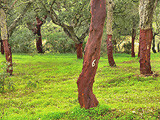 Even though the use of corks for sealing vessels can be detected back to the days of Cleopatra and Mark Antony, its use did not become the primary way of sealing wine until the 1700’s. This is when glass wine bottles came into popularity making the use of wine bottle corks almost essential.
Even though the use of corks for sealing vessels can be detected back to the days of Cleopatra and Mark Antony, its use did not become the primary way of sealing wine until the 1700’s. This is when glass wine bottles came into popularity making the use of wine bottle corks almost essential.

The majority of cork comes from Portugal with some also being produced in Spain, Italy and and a few other countries. It’s actually the bark of a cork oak tree. Traditionally, the bark is first harvested once the tree reaches 25 years of age, then every 9 or 10 years after that. A healthy cork tree can easily produce cork past the ripe age of 200 years.
The cork bark is stripped from the tree and then separated into grades. The cork strips are boiled and then dried for several weeks, then cut into smaller strips. The width of these strip are made to about equal a wine cork stopper’s height. It is these strips from which the wine cork is die cut or “punched”. The corks are then trimmed, and again, separated by grade.

Before shipping, the corks are treated with a hydrogen peroxide based bleach and packaged into bags along with SO2 gas. This is to sanitize the cork and make it ready for use.
If you need to buy corks, take a look at the corks we offer on our website. We have more than one grade based on how long you want to store your wine.
———————————————————————————————————
Ed Kraus is a 3rd generation home brewer/winemaker and has been an owner of E. C. Kraus since 1999. He has been helping individuals make better wine and beer for over 25 years.
